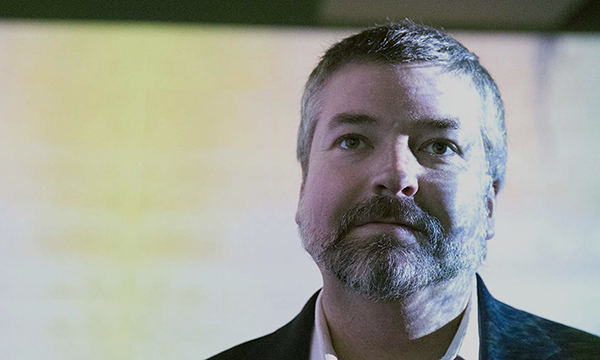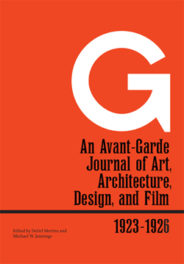Hearsay of the Soul, a video installation by Werner Herzog, lingers with you long after you’ve seen it. In an effort to investigate what makes the work so affecting, we invited a diverse group of experts to articulate how they experienced this multifaceted work, and how they understand it.
Following our talks with independent curator Paul Young, paintings curator Anne Woolett, and musicologist Nancy Perloff, we conclude the series with Getty Research Institute curator and video art specialist Glenn Phillips.

Curator Glenn Phillips, photographed inside Werner Herzog’s installation Hearsay of the Soul
What struck you most about Hearsay of the Soul?
When I first saw Hearsay at the Whitney Museum, I walked into the middle of the second movement, which still is the most powerful part for me. The piece says the most in that moment when you have this encounter with the musicians [Ernst Reijseger on cello and Harmen Fraanje on organ] and the etchings by Hercules Segers. It was only when the piece came to the Getty that I saw it from beginning to end. That was when I realized that you never see the etchings uncropped until the end.
I still have the same conclusions—that the etchings are secondary. Their age, their context, is completely secondary to the modern and mechanical way that this piece “looks” at the images. The digital images pan in a way that the eye does not; we can’t move our eyes that slowly.
What happens when older art is incorporated into contemporary practice?
Artists find inspiration from all sorts of places, not just within the realm of art. And just because someone is a living artist doesn’t mean that their only context can be other living artists. In fact it almost never is. This encounter between two different artists or ways of looking—two different worldviews—many find that to be productive territory.
Hearsay is a five-channel video installation. How would it differ if it were single channel?
If Hearsay were just one screen, it would lose the agency of the viewer. When watching a single screen, you are directed in a specific way. Once that expands into multiple screens, you are given the opportunity to edit internally by choosing where to look. If you wanted, you could just turn to the left and look at one screen during the entire piece.
Is Hearsay an immersive experience because of Herzog’s filmmaking experience?
To a degree, but in Hearsay he’s freed from story. The clear precedent is Herzog’s 2010 film Cave of Forgotten Dreams. I almost wonder if Herzog discovered his technique in that film. In Cave of Forgotten Dreams you have the camera lingering over cave paintings that are some of the most extraordinary art works anyone has ever seen, and no one had seen them except for a very small number of people.
Some of the music from Hearsay was used in earlier Herzog films.
It’s done in a very effective way in Cave of Forgotten Dreams. Of course Herzog wanted to expound on the nature of humanity and creativity, but as a documentary, the film needed to tell a true story. In the middle of telling that story, however, the film breaks into these long sequences of just music and image. The moments that are non-narrative—that are simply emulating a form of looking—are attempting to enhance that through very expressive music.
Is there narrative in Hearsay of the Soul?
To the degree that music has narrative. There is a narrative to the degree that any formal structure implies a movement from one idea to the next.
Does it matter whether Herzog finds personal meaning in Segers’s etchings?
I don’t think it does, because it’s not about the prints, it’s about the image. Artists have been making videos without the use of a camera since the early 1970’s. Simply working with images and applying motion to them is still working within the same language—video.
So as you said, the etchings are secondary.
The most important thing is the way of looking, and in particular the way of looking and listening together.
What’s the role of duration in video art?
We can always come back to art works throughout life and learn different things from them. We can also look at something for a minute and feel that we have enough. This comes back to the agency of the viewer. There’s nothing inherent to the history of video as a medium that implies you need to watch it in one way or another. An example is when an artist like Bruce Nauman turns on the camera and the piece ends when the tape runs out. The suggestion is that whatever’s happening is always happening, an activity. You can wander in and out, and that was often the way the presentations took place.
Is sitting through an entire video more rewarding than wandering in and out?
You’re only rewarded by any encounter with an artwork if you get something out of it. At the Research Institute we’re preparing a survey of Yvonne Rainer’s work, and I was just reading her autobiography. In it she tells this great story about watching Michael Snow’s Wavelength, one of the masterpieces of structural cinema. She watches the film for awhile and thinks: “All right, I get this.” So she takes a bathroom break and is gone just long enough to miss the murder/death scene in the middle of the film. For years afterwards she couldn’t understand what anyone was talking about.
____
See the previous interviews with independent curator Paul Young here, paintings curator Anne Woolett here, and musicologist Nancy Perloff here.




Comments on this post are now closed.